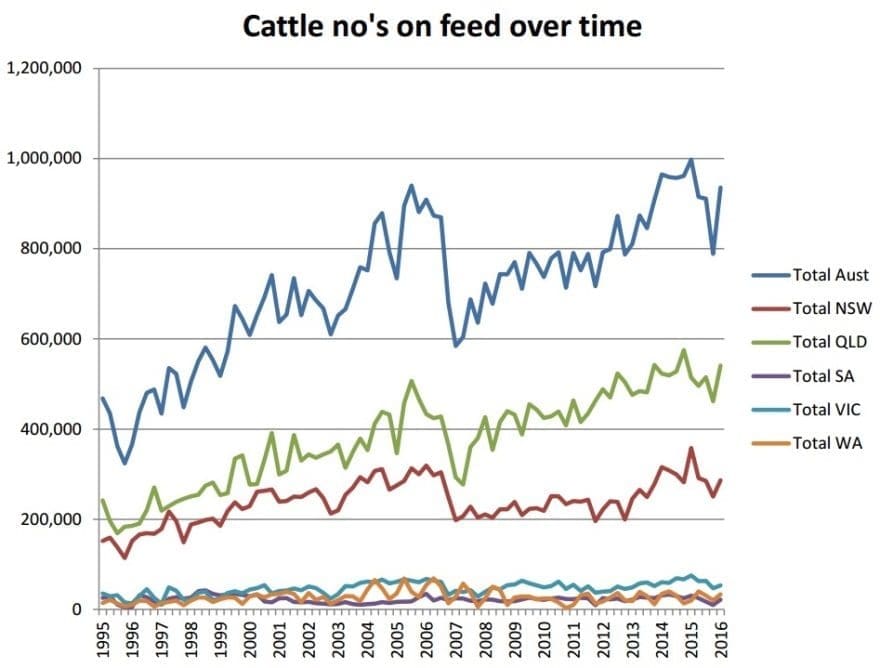CATTLE numbers on feed across Australia jumped by 18 percent for the December quarter over the previous September reporting period, as dry conditions start to impact on industry decisions over finishing cattle for slaughter.
Numbers rose by 146,915 head to 935,788 head over the final three months of 2016, according to the results of the quarterly ALFA/MLA survey released yesterday.
An increase was widely anticipated across the industry, as flagged in this Beef Central article published last week, but the sheer size of the advance took some by surprise.
Feedlot inventory rose in all regions, with the major feeding states of Queensland and New South Wales up 17pc and 14pc respectively on September results.
In Queensland feedlots, it was the larger yards +10,000 head in capacity where the biggest portion of growth was seen, jumping 63,000 head in just three months. In contrast there was a 14,000 head decline in Queensland yards 1000 head or less in capacity.
Similarly, larger yards +10,000 head NSW jumped 26pc since September, to just short of 198,000 head.
With the exception of WA which showed its normal summer seasonal advance in lotfeeding, numbers in small ‘opportunity’ yards less than 500 head capacity declined right across Australia, falling by 23pc.
There is a considerable lag in the release of quarterly feedlot survey data, and the March quarter figures, which will perhaps better reflect the rapidly drying seasonal conditions in parts of eastern Australia, are not due for release until early May.
As sharp as the December quarter rise was, it was still down 6.2pc in year-on-year comparisons against December 2015, when the industry hit a record-high COF figure of just short of one million head, at the end of a two-year drought cycle (see graph).

In other statistics from the survey, industry feeding capacity continues to grow, reaching 1.24 million head for the first time, as additional feedlot capacity comes on line. Beef Central covered this subject in this recent article.
Australian Lot Feeders Association president Tess Herbert said the December quarter results indicated a correlation with the seasonal conditions and tighter cattle supply, incentivising greater productivity through the feedlot sector.

Tess Herbert
“The 2016 year closed with average carcase weights across the industry reaching a record high of 287.8kg/head, as tighter cattle supply drove greater utilisation of the cattle that were available,” Ms Herbert said. “This was achieved through favourable seasonal conditions but also greater utilisation of cattle on feed.”
“Now we are seeing parts of Queensland and NSW drying off very quickly, whilst demand still remains for consistent beef supply despite some fluctuations in export markets. The jump in numbers reflects demand for the feedlot sector’s ability to provide a consistent quantity and quality of beef for our customers, irrespective of Australia’s variable weather conditions and cattle supply.”
The recent increase in feedlot capacity also showed confidence in the grainfed system, Ms Herbert said.
Meat & Livestock Australia’s manager of market information, Ben Thomas, said while the extent of the rise of cattle on feed was unexpected, low feed prices continued to assist the cost-of-gain in lotfeeding operations.
“Despite recovering from September quarter averages, ex-Darling Downs grain prices remained well below year-ago levels in the December quarter, with wheat prices 22pc lower at $225/t, while barley prices slipped 27pc to average $198/t,” Mr Thomas said.
Similarly, Riverina wheat prices eased 27pc year-on-year, to $183/t for the quarter, while barley declined 32pc to $158/tonne.
Mr Thomas said fodder prices had followed a similar trend, with the quarterly average for Darling Downs cereal and lucerne fodder easing 27pc and 23pc, to $230/t and $345/t, respectively.
Australian grainfed beef exports eased in the December quarter, down 7pc from year-earlier levels.
Grainfed exports totalled 64,290t shipped weight, which took total grainfed exports for 2016 to 260,386t.
“This eased 1pc from record high exports during 2015,” Mr Thomas said.
